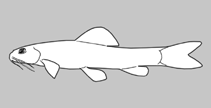Physoschistura tigrinum Lokeshwor & Vishwanath, 2012
Upload your photos and videos
Google imageNo image available for this species;
drawing shows typical species in Nemacheilidae.
Google imageNo image available for this species;
drawing shows typical species in Nemacheilidae.
Classification / Names Nombres comunes | Sinónimos | Catalog of Fishes(Género, Especie) | ITIS | CoL | WoRMS | Cloffa
> Cypriniformes (Carps) > Nemacheilidae (Brook loaches)
Etymology: Physoschistura: Greek, physa = bellows + Greek, schizein = divided + Greek, oura = tail (Ref. 45335); tigrinum: Named for the tiger-like bars on the body.
Etymology: Physoschistura: Greek, physa = bellows + Greek, schizein = divided + Greek, oura = tail (Ref. 45335); tigrinum: Named for the tiger-like bars on the body.
Environment: milieu / climate zone / depth range / distribution range Ecología
; agua dulce demersal. Tropical
Distribución Países | Áreas FAO | Ecosistemas | Ocurrencias, apariciones | Point map | Introducciones | Faunafri
Asia: Changa River, Chindwin drainage in Manipur, India.
Tamaño / Peso / Age
Short description Claves de identificación | Morfología | Morfometría
Radios blandos dorsales (total) : 13; Radios blandos anales: 9. Diagnosed from other species of Physoschistura in having the following combination of characters: side of body with 12-14 irregular light reddish brown bars (few become broken and forming blotches); back with 5-6 reddish brown irregular saddles; lateral line complete with 90-94 pores; caudal fin with 9+8 branched rays; axillary pelvic-fin lobe present but not prominent; male with suborbital flap; preoperculomandibular canal with 10 pores (Ref. 93078).
Life cycle and mating behavior Madurez | Reproducción | Puesta | Huevos | Fecundidad | Larva
Main reference
Upload your references | Referencias | Coordinador | Colaboradores
Lokeshwor, Y. and W. Vishwanath, 2012. A new loach of the genus Physoschistura Bănărescu & Nalbant (Teleostei: Nemacheilidae) from Chindwin basin, Manipur, India. Zootaxa 3586:95-102. (Ref. 93078)
CITES
Not Evaluated
Threat to humans
Harmless
Human uses
FAO - Publication: search | FishSource |
Más información
Trophic ecology
componentes alimenticios
Composición de la dieta
consumo de alimento
Food rations
Despredadores
componentes alimenticios
Composición de la dieta
consumo de alimento
Food rations
Despredadores
Ecology
Ecología
Ecología
Population dynamics
Coeficiente del crecimiento para
Max. ages / sizes
Length-weight rel.
Length-length rel.
Length-frequencies
Mass conversion
Reclutamiento
Abundancia
Coeficiente del crecimiento para
Max. ages / sizes
Length-weight rel.
Length-length rel.
Length-frequencies
Mass conversion
Reclutamiento
Abundancia
Life cycle
Reproducción
Madurez
Maturity/Gills rel.
Fecundidad
Puesta
Spawning aggregations
Huevos
Egg development
Larva
Dinámica larvaria
Reproducción
Madurez
Maturity/Gills rel.
Fecundidad
Puesta
Spawning aggregations
Huevos
Egg development
Larva
Dinámica larvaria
Anatomy
Superficie branquial
Brain
Otolith
Superficie branquial
Brain
Otolith
Physiology
Body composition
Nutrients
Consumo del oxígeno
Tipo de natación
Velocidad de natación
Visual pigments
Fish sound
Diseases & Parasites
Toxicity (LC50s)
Body composition
Nutrients
Consumo del oxígeno
Tipo de natación
Velocidad de natación
Visual pigments
Fish sound
Diseases & Parasites
Toxicity (LC50s)
Genetics
Genética
Heterozygosity
heritabilidad
Genética
Heterozygosity
heritabilidad
Human related
Aquaculture systems
Perfiles de acuicultura
Razas
Ciguatera cases
Stamps, coins, misc.
Aquaculture systems
Perfiles de acuicultura
Razas
Ciguatera cases
Stamps, coins, misc.
Herramientas
E-book | Guía de campo | Asistente para frecuencias de tallas | Herramienta de ciclo de vida | Mapa de puntos | Classification Tree
| Catch-MSY |
Special reports
Download XML
Fuentes de Internet
AFORO (otoliths) | Aquatic Commons | BHL | Cloffa | BOLDSystems | Websites from users | Check FishWatcher | CISTI | Catalog of Fishes: Género, Especie | DiscoverLife | ECOTOX | FAO - Publication: search | Faunafri | Fishipedia | Fishtrace | GenBank: genome, nucleotide | GloBI | Google Books | Google Scholar | Google | IGFA World Record | MitoFish | Otolith Atlas of Taiwan Fishes | PubMed | Reef Life Survey | Socotra Atlas | Árbol de la vida | Wikipedia: Go, búsqueda | World Records Freshwater Fishing | Zoobank | Expediente Zoológico
Estimates based on models
Phylogenetic diversity index (Ref. 82804): PD50 = 0.5002 [Uniqueness, from 0.5 = low to 2.0 = high].
Bayesian length-weight: a=0.00724 (0.00347 - 0.01512), b=3.01 (2.83 - 3.19), in cm total length, based on LWR estimates for this (Sub)family-body shape (Ref. 93245).
Nivel trófico (Ref. 69278): 2.8 ±0.3 se; based on size and trophs of closest relatives
Resiliencia (Ref. 120179): Medio, población duplicada en un tiempo mínimo de 1.4-4.4 años (Preliminary K or Fecundity.).
Fishing Vulnerability (Ref. 59153): Low vulnerability (10 of 100).




